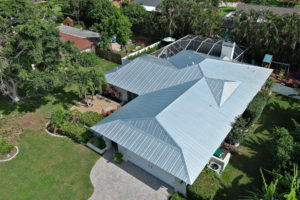Hidden Fastener Verus Exposed Fastener Roofs. What Are The Advantages and Disadvantages Of Each?
Hidden Fastener Roof:
Hidden fastener and exposed fastener roofs are two common types of metal roofing systems, each with its own advantages and disadvantages. Here’s a comparison of the two roofing systems Top Hat Roofing currently offers:
Advantages:
Aesthetic Appeal: Hidden fastener roofs provide a sleek and modern

appearance with smooth, uninterrupted lines. The absence of visible fasteners enhances the overall aesthetic of the roof.
Reduced Risk of Leakage: Since the fasteners are concealed beneath the roofing panels, there is less opportunity for water infiltration through the fastener holes, reducing the risk of leaks.
Improved Weather Resistance: Hidden fastener roofs are less prone to damage from wind uplift, as the fasteners are protected from exposure to the elements. This can result in improved weather resistance and durability.
Low Maintenance: With fewer exposed fasteners, hidden fastener roofs generally require less maintenance over time, as there are fewer points of potential failure.
Longer Lifespan: The concealed fastening system may contribute to a longer lifespan for the roof, as it helps protect the fasteners from corrosion and degradation.
Disadvantages:
Higher Cost: Hidden fastener roofs tend to be more expensive to install than exposed fastener roofs, as they require specialized installation techniques and materials.
Complex Installation: Installing hidden fastener roofs can be more complex and time-consuming than exposed fastener roofs, requiring skilled labor and precision.
Limited Design Options: Hidden fastener systems may have limited design options compared to exposed fastener systems, as not all profiles and materials are suitable for concealed fastening.
Exposed Fastener Roof:
Advantages:
Cost-Effective: Exposed fastener roofs are generally more cost-effective to install than hidden fastener roofs, as they require fewer materials and less labor.
Ease of Installation: Exposed fastener roofs are relatively easy to install, making them suitable for DIY projects or installations on simpler roof designs.
Versatility: Exposed fastener systems offer a wide range of design options, profiles, and materials, allowing for greater versatility in roof design.
Quick Installation: The installation process for exposed fastener roofs is typically faster than hidden fastener roofs, resulting in shorter installation times.
Easy Repairs: Exposed fastener roofs are easier to repair, as damaged panels can be easily replaced without having to remove adjacent panels.
Disadvantages:
Potential for Leakage: Exposed fastener roofs are more susceptible to water infiltration through the fastener holes, especially if the fasteners become loose or corroded over time.
Reduced Aesthetic Appeal: The visible fasteners on exposed fastener roofs can detract from the overall appearance of the roof, particularly in applications where aesthetics are important.
Maintenance Requirements: Exposed fastener roofs may require more frequent maintenance to check and tighten fasteners, especially in areas prone to high winds or extreme weather conditions.
Shorter Lifespan: The exposed fastening system may result in a shorter lifespan for the roof, as the fasteners are more susceptible to corrosion and degradation over time.
In summary, hidden fastener roofs offer a sleek appearance, improved weather resistance, and lower maintenance requirements but come with a higher cost and more complex installation process. Exposed fastener roofs are cost-effective, easy to install, and offer greater design versatility but may be more prone to leakage and have a shorter lifespan. The choice between the two depends on factors such as budget, aesthetic preferences, and performance requirements. If you have more questions contact Top Hat Roofing today for answers or a no-obligation consultation.
